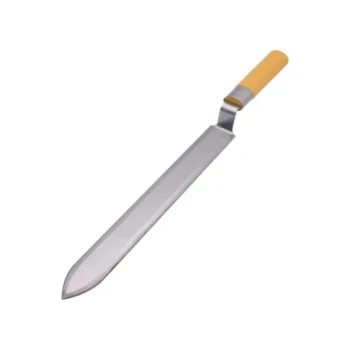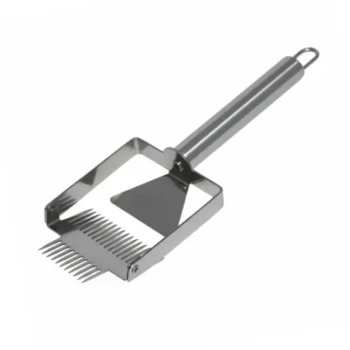When using a one-handed queen catcher, the most critical precautions are to operate the sliding mechanism slowly to avoid trapping the queen's legs or antennae and to apply only the gentlest pressure needed to immobilize her. Your primary goal is to isolate her safely, not to clamp down on her.
A one-handed queen catcher is a tool for delicate isolation, not forceful capture. Success hinges on patience and a light touch, ensuring the queen is guided into the chamber rather than trapped by its moving parts.

The Principles of Safe Queen Capture
The purpose of a queen catcher is to temporarily and safely contain the queen for inspection or marking. The entire process should be calm and deliberate to prevent injury to the most vital bee in the colony.
Positioning the Catcher
Before you do anything, locate the queen on the frame. Move slowly and deliberately.
Place the open end of the catcher directly over the queen. Try to do this in one smooth motion to avoid startling her.
Operating the Sliding Mechanism
This is the moment that requires the most care. The sliding gate is the primary source of potential injury.
As you close the gate, watch the queen's legs and antennae. Gently nudge her forward with the gate if needed, giving her time to walk fully into the chamber.
Immobilizing the Queen for Marking
Once the queen is fully inside, you can continue to slide the foam-padded plunger or gate forward.
The goal is to gently press her against the slotted side of the cage. Use just enough pressure to hold her still so you can mark her thorax through the slots. She should be immobilized, not crushed.
Common Pitfalls and How to Avoid Them
Rushing the process is the single greatest cause of injury. A queen is a delicate and expensive asset; taking a few extra seconds to ensure her safety is always the correct decision.
The Risk of Rushing
Hasty movements can cause the queen to run, making her harder to catch. It also dramatically increases the likelihood of trapping a leg or antenna in the sliding door as you quickly shut it.
Damaging Legs or Antennae
The thin, fast-moving plastic gate can easily sever a leg or antenna if it closes on her. This is why you must watch her position constantly as you close the device. A damaged queen may be rejected by the hive.
Applying Too Much Pressure
Crushing the queen's thorax or abdomen is a real risk if you apply too much pressure when immobilizing her. Remember, the foam plunger is only there to hold her gently in place against the opposite wall.
Making the Right Choice for Your Goal
Your approach should always prioritize the queen's safety. Building confidence with this tool comes from practice and a calm demeanor.
- If your primary focus is learning the technique: Practice on drones or worker bees first to get a feel for the required pressure and speed.
- If your primary focus is safely marking a queen: Ensure the hive is calm, use minimal smoke, and watch the queen's every move relative to the catcher's gate.
- If your primary focus is avoiding injury: Operate the sliding door slowly and deliberately, giving the queen ample time to move clear of the mechanism.
Ultimately, mastering this tool is about developing a feel for gentle, confident handling.
Summary Table:
| Precaution | Key Action | Purpose |
|---|---|---|
| Operate Slowly | Gently slide the mechanism | Avoid trapping legs/antennae |
| Apply Gentle Pressure | Use minimal force with plunger | Immobilize, not crush, the queen |
| Position Carefully | Place catcher over queen smoothly | Guide her safely into the chamber |
| Avoid Rushing | Work with patience and deliberation | Prevent startling and injuring the queen |
Master the art of safe queen handling with professional-grade equipment from HONESTBEE.
Confident, gentle handling starts with the right tools. We supply durable, precision-engineered one-handed queen catchers and other essential beekeeping supplies to commercial apiaries and equipment distributors through our wholesale operations. Our equipment is designed to give you the control and reliability you need to protect your most valuable bees.
Ready to equip your operation with tools that prioritize bee safety and handler efficiency?
Contact HONESTBEE today to discuss your wholesale needs and discover how our products can support your success.
Visual Guide

Related Products
- Plastic Queen Bee Catcher Marker Tube Holder for Queen Marking Bottle
- Queen Bee Marking Tube Cage Bottle Catcher Holder with Clear Plastic Plunger Marker
- HONESTBEE Professional Multi-Functional Hive Tool with Ergonomic Wood Handle
- Professional Multi-Function Stainless Steel Hive Tool
- Multi-Function Plier-Style Frame Grip Hive Tool
People Also Ask
- What are the advantages of a one-handed queen catcher? Mark Queens Safely and Efficiently
- When is the best time to mark a queen bee? Ensure Colony Success with Proper Timing
- What is a tube queen cage, and how is it used? A Guide to Safe Queen Marking
- What is the benefit of using instrumental insemination in honey bee breeding? Gain Absolute Genetic Control
- What is the purpose of a queen catcher in beekeeping? Safely Handle Your Queen Bee



















